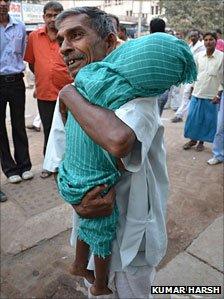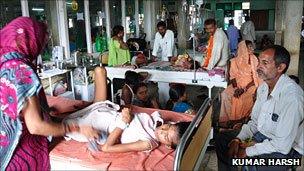Indian town battles against encephalitis
- Published

The majority of the victims are children
More than 460 people, mostly children, have died after a fresh outbreak of encephalitis in northern India. The BBC's Sanjoy Majumder travelled to Gorakhpur in Uttar Pradesh to find out why the town is struggling to cope with the disease.
Ward number 12 at Gorakhpur's main hospital is overflowing with sick children, two or three squeezed into a single bed.
Many of them are visibly sick and are having to be administered oxygen or being put on an intravenous drip.
Every day, 30 to 40 children are brought here after having contracted encephalitis. Many of them come from the countryside, after having travelled several hours because this is the best hospital in the region.
"I brought my daughter from our village 25km (15 miles) away," says one young woman.
"She was very sick. But here in the hospital, there are five babies dying every couple of hours. I am so frightened."
The hospital is trying its best to cope but is overwhelmed by the numbers.
"We have about 500 children in our ward and only 95 beds," says Dr KP Kushwaha, the hospital's chief paediatrician.
Those who aren't lucky to make it to a bed are made to wait with their parents in the corridor outside which is filled to capacity. The children lie on the floor, exposed to the dust and dirt.
But lack of space is not the only issue.
Regular outbreak
The hospital does not have enough doctors and so medical students are being roped in to help out.
Gorakhpur experiences an outbreak of encephalitis every year, typically after the monsoon season when stagnant water left over after the rains becomes a breeding ground for mosquitoes.
But this year's strain is not the more common Japanese encephalitis, doctors say, but a virus being blamed on contaminated water.
"We had managed to contain the spread of Japanese encephalitis with our immunisation programme," says Dr Kushwaha.
"But this has proved to be more difficult."
Children, with lower immunity systems are particularly vulnerable.

Hundreds of patients have been admitted to Gorakhpur's main hospital
Ritu, a baby girl aged 18 months, was one of the many who didn't make it.
Her mother, Lata, clutches at a frayed photograph of her daughter as she recalls what happened.
"She was very sick at home. We tried to cure her through medicines but when she just didn't get better, we took her to the hospital."
She died in less than a week.
Officials say part of the problem is that many people fail to bring their children to a medical facility in time.
'Neglected'
"In my assessment, we can reduce the deaths by 50% if people follow basic hygiene and then take their child to the nearest hospital quickly," says Sanjay Kumar, Gorakhpur's top administrator.
But the families of many of those affected say that's quite hard to do.
"There are no proper hospitals near our village," says Manju whose three-year-old boy is recovering from encephalitis.
"It's a long journey - six to seven hours. And we don't know how long we'll have to stay here. That's why not many like to come."
This is one of India's most neglected regions and those affected are among the poorest.
Lack of proper sanitation and access to clean water sources is being described as the main reason for the spread of the disease.
So, with every passing hour more children are being brought into the hospital - not all of them will survive.
- Published12 October 2011
- Published21 June 2011